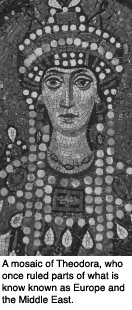Back to the fashion future
The Byzantine period, which dates back between the fifth and mid-fifteenth centuries, or between Ancient Rome and The Middle Ages, was better know for its rulers and wars than its fashion statements.
 During that time there were an infamous couple, Justinian and Theodora, who at one point ruled. They were equivalent to the famous couples we have nowadays, like the Beckhams, (who I am obsessed with by the way and you will figure that out in articles to come) or say Beyonce and Jay Z or Brad and Angelina, but cooler. They both have the typical rags to riches story, Justinian was a farm boy, Theodora, the daughter of a bear feeder and as young lady was, to put it bluntly, a prostitute. They met and the rest is history, literally. They both had very posh taste. Their everyday clothes were silk robes embroidered with pearls and gemstones. Their palace, or in modern terms, crib, in the fifth century was very elaborate.
During that time there were an infamous couple, Justinian and Theodora, who at one point ruled. They were equivalent to the famous couples we have nowadays, like the Beckhams, (who I am obsessed with by the way and you will figure that out in articles to come) or say Beyonce and Jay Z or Brad and Angelina, but cooler. They both have the typical rags to riches story, Justinian was a farm boy, Theodora, the daughter of a bear feeder and as young lady was, to put it bluntly, a prostitute. They met and the rest is history, literally. They both had very posh taste. Their everyday clothes were silk robes embroidered with pearls and gemstones. Their palace, or in modern terms, crib, in the fifth century was very elaborate.
According to The Complete History of Costume & Fashion by Bronwyn Cosgrave, the ruler's palace “doors were made of solid silver and the walls were covered with mosaics (fancy tile).” Inside their house were pure silver columns, silver tables, gold furniture and marble floors. Guests who visited the palace walked on rose petals and in their garden, peacocks wandered and also outside were scented water fountains. No joke! This all came from the text and just to make clear that no else ever before them had this extravagant lifestyle.
Women were seen as pretty much pointless back then and were secluded and told to stay in their homes and do domestic duties. With one exception of course, Theodora, who demanded respect. She was said to be a ‘complex' women who was also harsh and would have her enemies drowned and/or poisoned. Theodora was a charitable woman who saved prostitutes and brought them to her home and clothed them. She made it so “pimping” (yes, that word was actually used back then) was a crime in the city. Theodora was quite prominent for a traditional emperor's wife, let alone women. It was very rare to read about a respected women back then having significance, other than Cleopatra of course.
“Her silk dresses were enhanced with precious stones and lavish gold embroidery. She wore a gold collar around her neck, and just like her clothing, her jewelry was draped over her body. Ropes of pearl, emeralds and rubies graced her neck. She wore a heavy gold crown with dripping pearls and emeralds,” according to The Complete History of Costume & Fashion.
Justinian had his own fashion moments too. When having to attend a meeting with other high-ranking people, he showed up in “gold embroidered jewel-encrusted purple robes, with high-heeled red buskin (boot) and a spiked tiara. Throughout Byzantium from that moment on, clothing became a symbol of stature and rank.”













